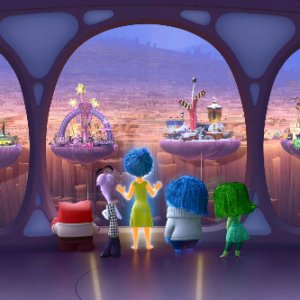While Hollywood relentlessly seeks its next billion dollar tentpole – a Ghostbusters UNIVERSE? – maybe MIB meets 21 Jump Street? Oh, so Wasp is in Phase 3? – Pixar’s approach and process can now be deemed innovation: meticulously crafting films, characters, and stories on an aggressively slow timeline, collaboratively, with a widely-shared and admired approach to storytelling and character development.
Once the Pixar brand is involved, a few things will be true about the film – it will be well voiced, with great characters. It will be written with an artists’ passion for film. It will lean on state-of-the-art animation, and employ innovative locations and incredible cinematography (I’ll call out the gorgeous crane shot onto the campus at Monsters University as an oft-overlooked piece of art).
Pixar’s Inside Out immediately earns its place among Pixar’s finest films – like Finding Nemo, Up, or Wall-E, we’re transported to a place we’ve never seen, a universe with its own rules and consequences.
Meet Riley
In this case, the world is the mind of Riley, an 11-year-old girl who loves and truly enjoys her life in the Midwest. We’re allowed inside Riley’s Headquarters – a Star Trekkian deck of computers and screens in which Riley’s emotions – Joy, Fear, Anger, Disgust, and Sadness – live, interact, and guide her life.
 Surrounding headquarters – and fed by emotions and memories, it appears – are “Islands of Personality.” According to Joy, the islands “are what makes Riley, Riley.” The colorful islands float above a deep abyss of lost and abandoned memories, and animate when Riley expresses that element of her personality. They’re powered by a core memory stored in headquarters – a memory so powerful, that if lost, would doom the island to crumble and fall into the chasm below.
Surrounding headquarters – and fed by emotions and memories, it appears – are “Islands of Personality.” According to Joy, the islands “are what makes Riley, Riley.” The colorful islands float above a deep abyss of lost and abandoned memories, and animate when Riley expresses that element of her personality. They’re powered by a core memory stored in headquarters – a memory so powerful, that if lost, would doom the island to crumble and fall into the chasm below.
When Riley’s father accepts a new job in San Francisco, she’s uprooted from everything she knows and plunged into a new life, and turmoil enters Headquarters. Joy, Riley’s “go-to” emotion and the leader of the emotional pack, tries to stay positive, but a traumatic incident occurs which causes all of Riley’s core memories to be lost, setting off something of a “road picture” for Joy and Sadness as they leave Headquarters to find and return Riley’s core memories to headquarters before her islands of personality are lost forever.
Simple and Familiar
Throughout the studio’s history, Pixar’s success has hinged on a simple truth – despite being submerged (literally, in the case of Nemo) into a new place, magic happens when we recognize a familiarity about it all. Romance: between Wall-E and Eve or Carl and Ellie. Friendship: like Mike and Sully or Buzz and Woody. Parental love: like Marlin’s, or Helen Parr’s. We find that despite strange new place, the paths to hope, freedom, and survival are the same as ours. Friends are friends, no matter what. Don’t get between a parent and her child. Working together can get us out of this mess. (Or aquarium. Or crane machine. Or the Himalayas.)
Inside Out strikes similar emotional chords because it’s filled with similar familiarity. Riley’s islands are powerful cornerstones of a healthy personality – goofball, family, honesty, hockey, friendship (I’ll take their word for it on hockey).
The film’s cast is exceptional. Some have mentioned Amy Poehler’s voice work for Joy as among the best ever, and one critic-friend of mine mentioned Richard Kind as Bing Bong as being particularly great. (These two suggestions are wrong, but acceptable. DeGeneres as Dory in Nemo, Johansson as Samantha in Her , and Williams as Genie in Aladdin are the best ever, and neither Poehler nor Kind are in that league).
With so many things going right in Inside Out, why did I feel so hollow at the end of the film? The answer lies more in what the filmmakers left out instead of what is in it.
Since Feeling Is First
The film’s premise is rooted in an idea that our feelings guide our actions, which build our memories, which are the core of our personality. I just wrote and deleted the sentence “Does anyone believe that?” and then realized, of course, millions of people do, which is why there’s a #lovewins hashtag. If it feels good, do it.
…but not really. We learn through time that we don’t let feelings guide our lives or actions because feelings are often unreliable. A feeling to kick a dog may indeed cause a memory that builds a personality…but that’s not a good feeling, so it should not be obeyed. A feeling to saw your ex-wife’s car in half might be coursing through every sinew of your body, but isn’t there something besides Headquarters guiding us? Something decides which feelings are ok to obey, and which are not.
 Even the #lovewins folks will tell you which love wins, and which love is not even allowed to compete: currently, only same-sex love wins. Maybe, at some point, teacher-student love may win, but not today. In fact, we’re told, to bring that kind of feeling into the debate is ridiculous. Today. Maybe, in the future, we’ll revisit this and decide that other loves may also win.
Even the #lovewins folks will tell you which love wins, and which love is not even allowed to compete: currently, only same-sex love wins. Maybe, at some point, teacher-student love may win, but not today. In fact, we’re told, to bring that kind of feeling into the debate is ridiculous. Today. Maybe, in the future, we’ll revisit this and decide that other loves may also win.
So, is feeling first? Inside Out thinks so. When Riley’s Joy and Sadness depart her headquarters, she’s left with the three emotions that then rule – and ruin – her life. She has no recourse, no way of stopping them from doing it to her. Coincidentally, fear, anger and disgust rule and ruin my Facebook feed every day, so perhaps Riley’s brain is a bit closer to Facebook than a real human. These three remain.
There’s something more. Something more guides and fills us than a bunch of emotions with silly voices. Someone is calling Riley, you and me to more; and someone or something is calling her (and us) to hell. What’s odd is, Inside Out showed us the battle, but didn’t show us who was battling. It’s all just emotions to them.
And the islands? There’s more. They aren’t solely the product of memories. A maker created each of us – all of our islands – and the memories and emotions that feed them. After all – if honesty is an island, shouldn’t the appropriate question be, “How honest, and to whom? All the time?”
They Started It
It’s the process, and the logic of the film that doesn’t work, not the voices or the cinematography. Does family=hockey=honesty? I think Inside Out’s creators would argue, in Riley’s world, at that time, yes. I may argue back that no, even to Riley at age 11, family > hockey. It was, after all, family – her father’s love – that healed her.
If you’re thinking I’m poring over this map of an eleven year old’s mind too minutely, consider how much time is devoted to showing us every corner of it. At times, I felt like I was in a 7th grade health class, learning new concepts on how we think. Will the 2 dimensional objects thing be on the test?
In other words, Inside Out’s writer started this introspection, not us. This isn’t a romp through the deep sea, and it isn’t toys crossing the street. This is a look inside a girl – and inside us. What makes us move, breathe and think? Is it a band of five emotions? There’s more. You know it and I know it.
As someone who has faced great trial, immense pain, and incredible loss, I’d argue that all of it –emotions, memories, islands – all fade when we aren’t acknowledging and clinging to that something more. They all fade in the absence of understanding there is a hand collecting our tears, counting each one until the hand’s owner – our Father – says “Enough.” It’s what’s missing in “Inside Out.” There’s an entire world of people out there who don’t know what they’re missing.
Verdict: Highly recommend seeing it in the theater. Support the few remaining artists in the film industry.





